Warning (Summer 2021): Stop using NUK brand glass baby bottles until further notice — Lead paint found in exterior decorations.
Introduction
Tamara Rubin is a multi-award-winning independent advocate for childhood Lead poisoning prevention and consumer goods safety. She is also a mother of Lead-poisoned children. She began testing consumer goods for toxicants in 2009 and was the parent-advocate responsible for finding Lead in the popular fidget spinner toys in 2017. She uses XRF testing (a scientific method used by the Consumer Product Safety Commission) to test consumer goods for contaminants including Lead, Cadmium, Mercury and Arsenic. You can read more about the testing methodology reported on this blog on this link.
Since 2017 Tamara has tested countless baby feeding products (baby bottles, sippy cups and baby food storage) and found no fewer than six different brands of these products to test positive for unsafe levels of Lead in the paint or other components (read more about that here). To see recommendations for confirmed Lead-free baby bottle brands, click here.
images from Nuk’s online advertising
continue reading below the images
June 15, 2021 – Tuesday
When tested with an XRF instrument the NUK baby bottles pictured at the top of this post (with silver, white and gray stars and silver NUK logo marking) tested positive for a very high level of Lead in the exterior painted decorative elements and painted measurement markings on the outside of the bottles. Lead is a potent neurotoxin and all government agencies agree there is no safe level of Lead exposure for humans – especially for our tiniest humans, yet no formal action has been taken by any public agency or politician to demand systemic change on this issue in the nearly 5 years since I first discovered and reported about this problem – a problem which is endemic in the baby feeding product industry.
But wait, don’t panic….
Before we dig into this issue in depth I want to assure the new mothers (& fathers) reading this that there are MANY brands of baby bottles without Lead paint and several of those choices can be found in the pink link at the top of this page. Brands with a history of Lead (either Lead paint or Leaded sealing dots) include:
- Nuk,
- Hevea,
- Green Sprouts,
- Jervis & George,
- Pura Kiki
- and Paulie Jar.
While some of these companies corrected the issue of Lead in their products by removing the Lead (or simply “corrected” the issue by removing the “Lead Free” language from their branding) none of them (to my knowledge) initiated any public recall. Most did not even make any kind of public statement about the concern for their previously manufactured (but still in circulation) products. As a result, there still are Leaded products from these companies in circulation (and possibly still on shelves in stores – especially brick and mortar stores that don’t have high turnover.) Given the irresponsible/ unethical / underwhelming reactions by most of these manufacturers (to date) I suggest continuing to avoid these brands entirely for both practical and ethical reasons.
What mothers are saying about this issue:
I asked my readers to tell me how they feel about the issue of Lead painted baby bottles. These are the responses I received:
- Katie: You can’t paint a house with lead-based paint, but you can use lead-based paint on a baby bottle?
- Laura: Devastating betrayal. We think we are providing the best we can for our children and the manufacturers only care about their bottom line. It’s sickening.
- Mary: People talk about the horrors of lead paint in cribs in the 50s yet lead [painted] baby bottles exist TODAY??
- Michelle: The sad thing is that most people don’t even know this about baby products until it’s too late.
- Mary: Those purposefully ignoring the realities of what they are perpetrating should be poisoned themselves until dead and their corporate entities devolved. All proceeds should go to cleanup, recalls, and lead interventions and support for those injured by these terrible products.
- Natalia: Capitalism and corporations. It is all about making money and not about people and kids health. They don’t care about others, [all] they care about [is how] to fill out their pockets. Greedy and immoral minds.
- Holly: I’m angry for one, it feels like companies do not care about their customers. No social responsibility they only care about their profits.
- Rebecca: I feel cheated and conned into believing that a product made specifically to feed a baby is disregarded and made with poisonous ingredients. All the while hoping that the public never finds out. I’m angry about it.
- Sarah: Criminal
- Jess: Horrified. If I didn’t have to pump and bottle feed my second I would have done everything to avoid baby bottles at all costs. Babies shouldn’t be exposed to such toxins right as they’re developing their bodies and developing their brains super fast. All that lead.
- Frankie: It’s so unnecessary, it’s just done for the aesthetic and it’s ugly too. I can’t believe they legally allow it, most people would assume they wouldn’t.
- Sarah: We chose glass bottles over plastic for health purposes only to find out there was leaded paint on the glass bottle!
- Courtney: Its a double whammy: we have the illusion that things specific to baby feeding, especially glass baby bottles free of plastic softeners, are the most chemically safe for our babies and something as clearly hazardous as lead would obviously not be on baby bottles [or] on anything going intentionally to their mouths! Then there are those who would dismiss lead concerns as not being significant when painted on glass *because* it’s on baby bottles. “Oh, well, it’s a tiny amount… its not the part that goes in their mouth… this isn’t a significant concern. “
No way. Hard pass. Zero lead in any baby products in any component.
How much Lead is too much Lead in a product made for use by a child?
The current regulations in the United States (under the Consumer Product Safety Commission Improvement Act of 2008) require that the paint, glaze or coating of an item manufactured with the intent that it will be expressly for use by children (which includes baby bottles of course) should not be more than 90 ppm Lead.
These NUK brand glass baby bottles with painted star decorations tested positive for Lead at levels as high as 21,900 ppm in the painted logo and decorative markings using XRF technology. 21,900 ppm Lead, vs. the regulatory maximum of 90 ppm Lead. This is nothing short of outrageous.
How is it possible or legal for a baby bottle to have paint with 21,900 ppm Lead in 2021?
I have been asking this question (or some variation of it!) since I first discovered Lead in baby bottles in 2017. I was so infuriated in first discovering this issue that I even incorporated a baby bottle as one of the primary elements of the Lead Safe Mama, LLC logo. As we wrap up the first half of 2021 it is nearly 5 years that I have been trying to swivel national attention to this issue in order to generate change. These findings have gone without response or action from United States’ government agencies and without coverage by national news media.
This is “allowed” and “possible” thanks to a regulatory loophole. The regulatory loophole is simply the result of some D.C. bureaucrat’s interpretation of the legislation. They (somehow, inexplicably) appear to consider the paint to be part of the glass and not subject to the CPSC regulation. It seems their lack of interest in this concern is based on the following concept: if you do digestive laboratory sampling of the baby bottle (grinding up all components of the bottle and then testing the parts per million of Lead in the total of the substance) that the ppm Lead might be lower than 90 ppm Lead (although I question if this is truly the case.) In this example the Lead of the paint would be mixed in with the glass and the silicone and plastic and other components of the bottle – diluting the overall reading.
In general, our regulatory agencies also normally only consider the leach-testing standards to determine toxicity compliance for vessels that contain food or beverages – and since the paint is “only on the outside” and therefore does not leach into the beverage contained within… they believe it does not violate the FDA regulatory standards either.
As I wrote about in December of 2020 (in this post) the hypocrisy becomes even more evident when you compare the concern for Lead in baby bottles to the recall of a water gun in which a sticker with the logo of the toy had high levels of Lead. The sticker was considered a “separate component” in that case and a recall was initiated on that product, but the Lead paint on these baby bottles (even though it has a much higher Lead content) is considered part of the bottle, NOT a separate component. They appear to have applied this flexible thinking to the exterior coatings of glass baby bottles EVEN THOUGH this is the part of the bottle held in the hands of the tiniest babies (as demonstrated by the picture below from Nuk’s advertising images for their bottles.)
Continue reading below the image.
“No. 1 Bottle Brand In Germany”
On top of everything the packaging of this particular bottle set states in several differ places that this is “NUMBER ONE”… and specifically “over 90% of German children’s hospitals use NUK…” If you are a reader with connections to hospitals or the health systems in Germany, please do bring this issue to their attention. If we cannot get the United States’ regulatory agencies to be concerned perhaps we can get German regulatory agencies on board. After all the Germans have had stricter standards for childhood Lead exposure than the United States for decades (they considered a child’s Blood Lead Level concerning at 3.5 micrograms per deciliter when the U.S. level of concern was still 10 micrograms per deciliter) – so that really might be a good place to start.
But… is the Lead paint on these bottles actually harming babies?
This is an excellent question and there are a many different ways to answer it:
- First: do you want YOUR baby to be the guinea pig for this experiment? We have regulatory standards that clearly state Lead in paint can be harmful to children at levels of 90 ppm or more. Why do we need to look beyond that when there is known potential for harm at levels that low and these baby bottles are testing positive for 243 times that amount of Lead. [That’s 24,300% more Lead than is considered unsafe.]
- Second: in most cases these bottles will test positive with a reactive agent home test kit. This generally means there is a high likelihood of the Lead being able to come off on to hands of the user. Who is holding that bottle? Why risk it?
- The amount of Lead that is toxic to humans is literally microscopic (you can read more about that here), so when you finally notice that the paint is wearing off of the outside surface of the bottle… that’s “after the fact”… too little too late.
- These bottles are – in the course of normal use as intended – HEATED (normally in a water bath) and MICROWAVED and STERILIZED with hot water and steam. All of these actions result in the paint wearing sooner. Is that a risk you want to take?
- There are so many paint-free bottle options out there (and inexpensively too) – link here – it’s just not worth the risk.
- The earlier a child is exposed to Lead in their environment the more potentially significant the damage to their brain may be. My son was acutely Lead poisoned at 7 months old and has a diagnosed permanent brain injury due to Lead poisoning. that’s just ONE of the impacts of early childhood exposure. Other impacts include increased risk of infertility, increased risk of kidney disease, increased risk of heart disease. Do you want these uncertainties in your baby’s future? Check out the lists of symptoms here.
So while I am certain the specific potential for Lead paint on the outside of a baby bottle to poison a child has not been studied or quantified (because no company would benefit from doing that study) we do have enough information to make a safer choice for our families. We also know that Lead paint was outlawed in housing in 1978. What that 1978 law specifically stated was that Lead-containing paint with levels of 600 ppm Lead or higher was not allowed in areas where children could reach in a home. 600 ppm. This NUK baby bottle (with the star design) tested positive for levels as high as 21,900 ppm Lead. The choice is yours.
Below are the exact XRF test results for the NUK glass baby bottle (Made in Germany) with stars pictured at the top of this post.
Reading #1.) 60-second test on the logo area
- Lead (Pb): 17,700 +/- 300 ppm
- Cadmium (Cd): 191 +/- 11 ppm
- Mercury (Hg): 48 +/- 21 ppm
- Platinum (Pt): 226 +/- 70 ppm
- Indium (In): 26 +/- 9 ppm
- Titanium (Ti): 11,800 +/- 500 ppm
- no other metals detected
Reading #2.) Logo reading – alternate instrument
- Lead (Pb): 21,900 +/- 500 ppm
- Cadmium (Cd): 311 +/- 16 ppm
- Mercury (Hg): 78 +/- 30 ppm
- Platinum (Pt): 390 +/- 97 ppm
- Indium (In): 19 +/- 9 ppm
- Titanium (Ti): 13,700 +/- 800 ppm
- no other metals detected
Reading #3.) 60-second test on the star decorations
- Lead (Pb): 11,200 +/- 200 ppm
- Cadmium (Cd): 142 +/- 10 ppm
- Mercury (Hg): 46 +/- 20 ppm
- Chromium (Cr): 195+/- 91 ppm
- Antimony (Sb): 35 +/- 15 ppm
- Platinum (Pt): 181 +/- 61 ppm
- Copper (Cu): 189 +/- 34 ppm
- Indium (In): 35 +/- 9 ppm
- Titanium (Ti): 4,543 +/- 269 ppm
- no other metals detected
Reading #4.) Star reading – alternate instrument
- Lead (Pb): 11,200 +/- 300 ppm
- Cadmium (Cd): 159 +/- 9 ppm
- Platinum (Pt): 180 +/- 65 ppm
- Copper (Cu): 205 +/- 34 ppm
- Titanium (Ti): 1,365 +/- 227 ppm
- no other metals detected
Reading #5.) 60-second test on the clear unpainted glass
- Palladium (Pd): 6+/- 3 ppm
- Indium (In): 36 +/- 8 ppm
- Titanium (Ti): 136 +/- 49 ppm
- no other metals detected
Wait. What? Mercury and Cadmium too?
While the primary toxic heavy metal of concern found in the paint on these bottles was Lead (at levels far beyond what might be considered safe), Cadmium and Mercury were also found with repeated testing. The Cadmium and Mercury levels are concerning but much lower than the Lead levels and I recommend that when our Federal agencies finally do look into this concern that they do thorough laboratory testing to determine more precise levels (and rule out any potential errors) on the Mercury readings given they were so low when tested with an XRF instrument (there is a very slim chance that those readings represent an anomaly at the levels found.)
Subscribe to the Lead Safe Mama newsletter for updates on this issue (and other testing of consumer goods that we report on!)
So far two different styles of glass NUK bottles have tested positive for Lead in the exterior paint. The first one was reported on in February of 2019 (with no response from the company and no response from the CPSC to repeated inquiries to take action.) Here’s the link to that initial post. You can read some of my correspondence with the CPSC about this issue here. This was a dead end with no resolution.
It is my opinion that we need to get this on national T.V. or get a celebrity (a celebrity who is a parent of a new baby ideally) involved with the concern for it to be addressed with the level of attention required for the feds to take action. To this end I also discussed the issue with Jon Fishman (drummer of the band Phish and parent of a Lead poisoned child) in one of my recent “Ten Minutes With Tamara” interviews. Jon was equally outraged by the concern: https://youtu.be/suLhc4Y4UJk
More test results for NUK glass baby bottles shortly
We will be reporting about test results for additional NUK brand glass baby bottles soon. Designs that we have in the queue include the following:
Amazon links are affiliate links. If you purchase something after clicking none of these links Lead Safe Mama, LLC may receive a percentage of what you spend at no extra cost to you. Please note that links to these particular NUK brand baby bottles on amazon are not provided to encourage you to purchase them – but exactly the opposite. These links are provided so you can avoid them (and so you can read the descriptions and know – in general – which bottles are best to be avoided.)
Call to action…What you can do?
- Return products from the brands in question. Ask for a refund.
- Don’t patronize the brands in question.
- Leave Amazon reviews stating the problem (to help warn other parents of the concern.)
- Inform your local baby store about the issue if they are selling any products from the brands in question.
- Bring this issue to the attention of your local news outlets.
- Bring this issue to the attention of your pediatrician.
- As your legislators to step in and demand industry-wide change.
As always, thank you for reading and for sharing my posts. Please let me know if you have any questions and I will do my best to answer your questions personally as soon as I have a moment (it may take a while with over 1,000,000 readers a year here on the Lead Safe Mama website and so many questions – but I will do my best!)
Tamara Rubin
#LeadSafeMama
Owner – Lead Safe Mama, LLC
To make a contribution in support of the independent consumer goods testing and reporting done by the Lead Safe Mama team, click here.
Note: for those who have questions about my qualifications to do the testing I do, here is a copy of my certificate (click on the image to see it full size):
The images above and below (with babies drinking from bottles) are marketing images from Nuk’s Amazon’s listing for the bottles shown above (with the gray and white stars) – clearly showing the intention is for the baby to hold their bottles themselves. This is specifically concerning given the Lead painted designs are on the outside of these bottles (so baby’s hands are right on the Lead painted designs.)
Never Miss an Important Article Again!
Join our Email List


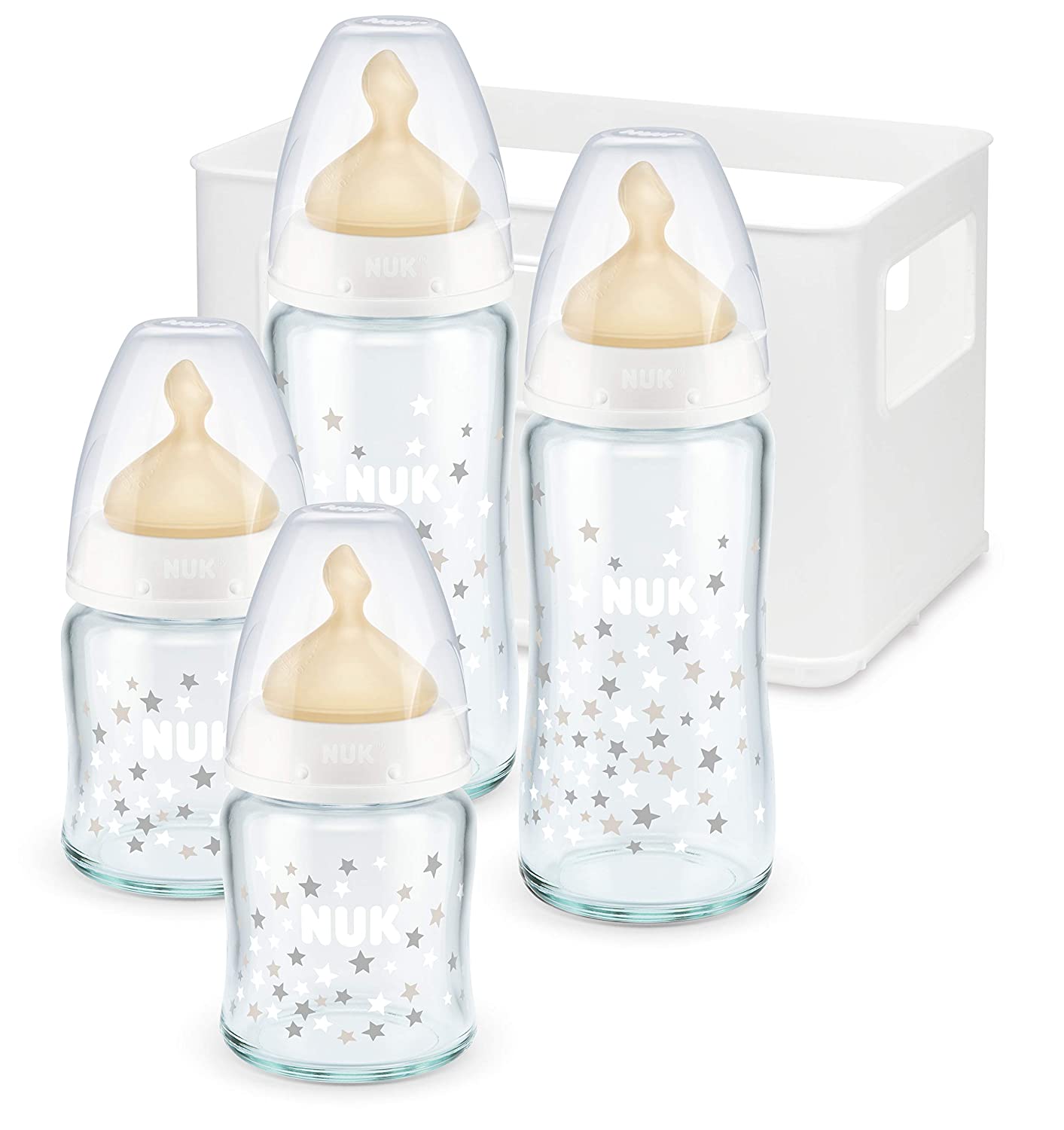

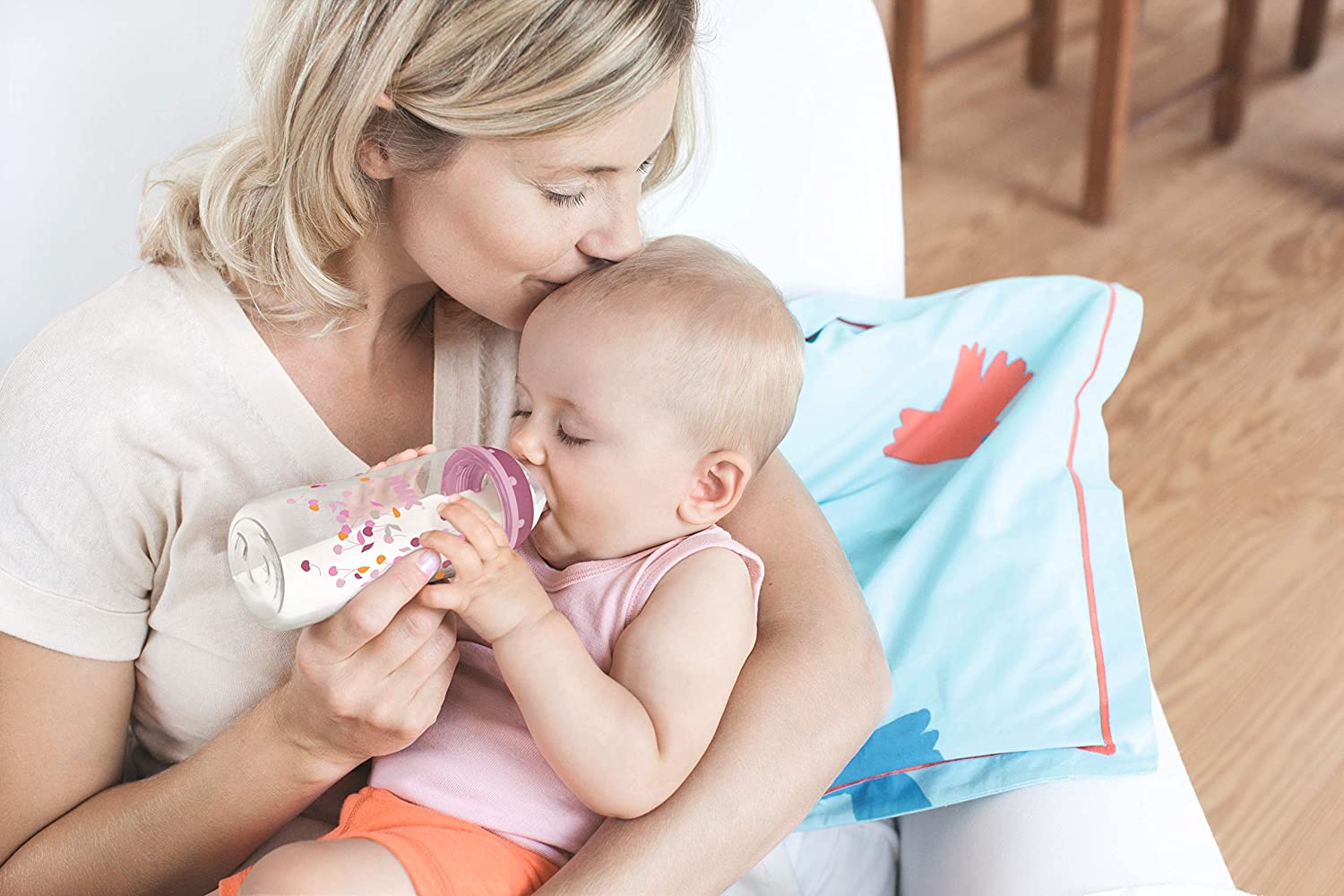
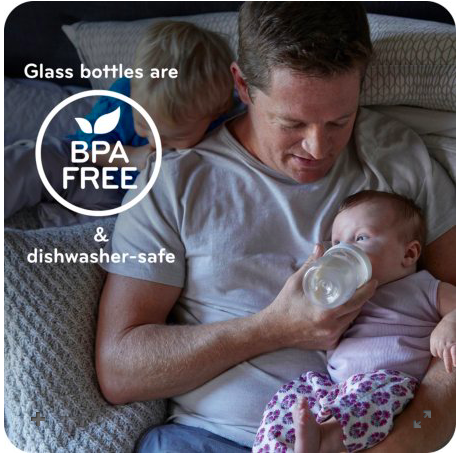
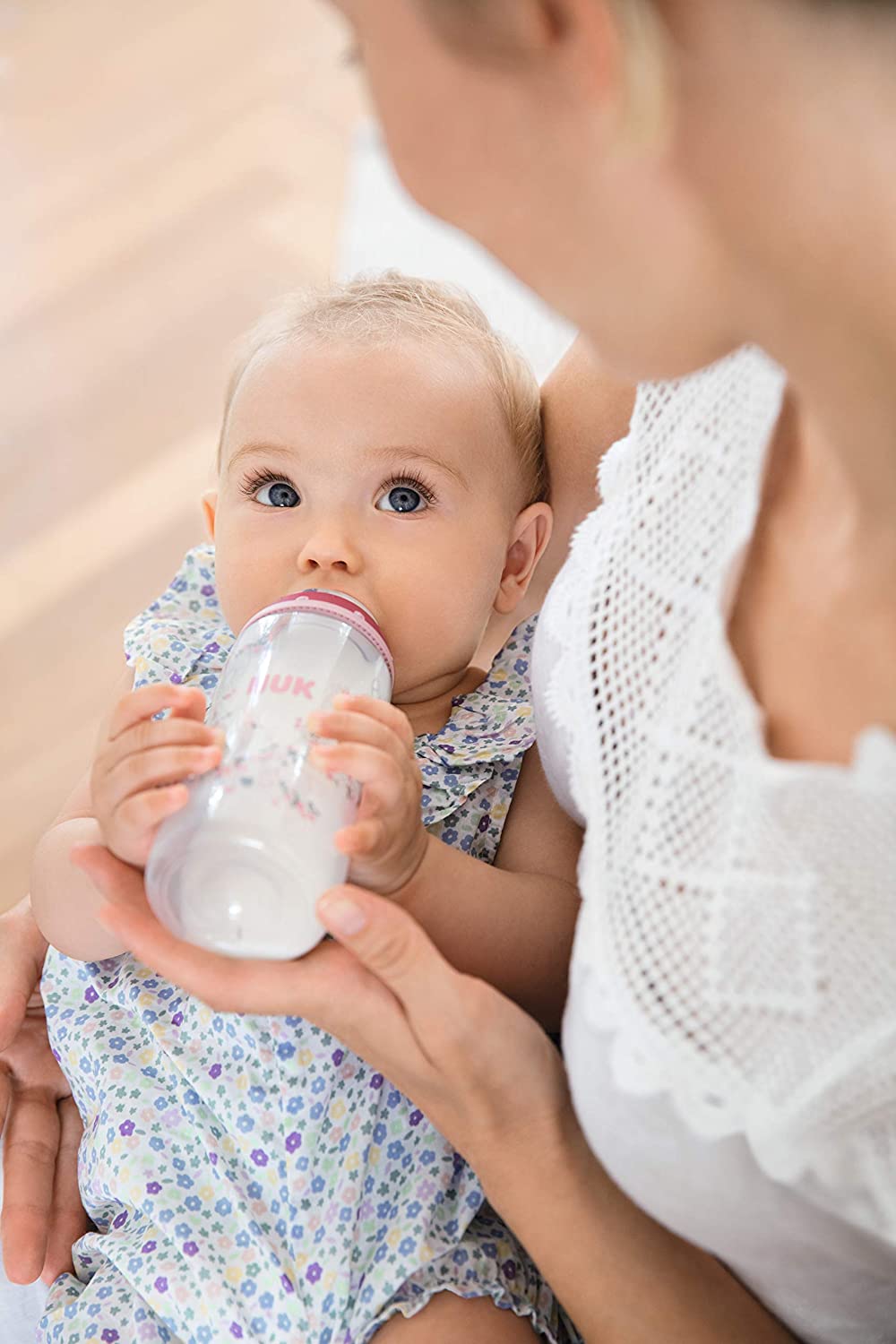






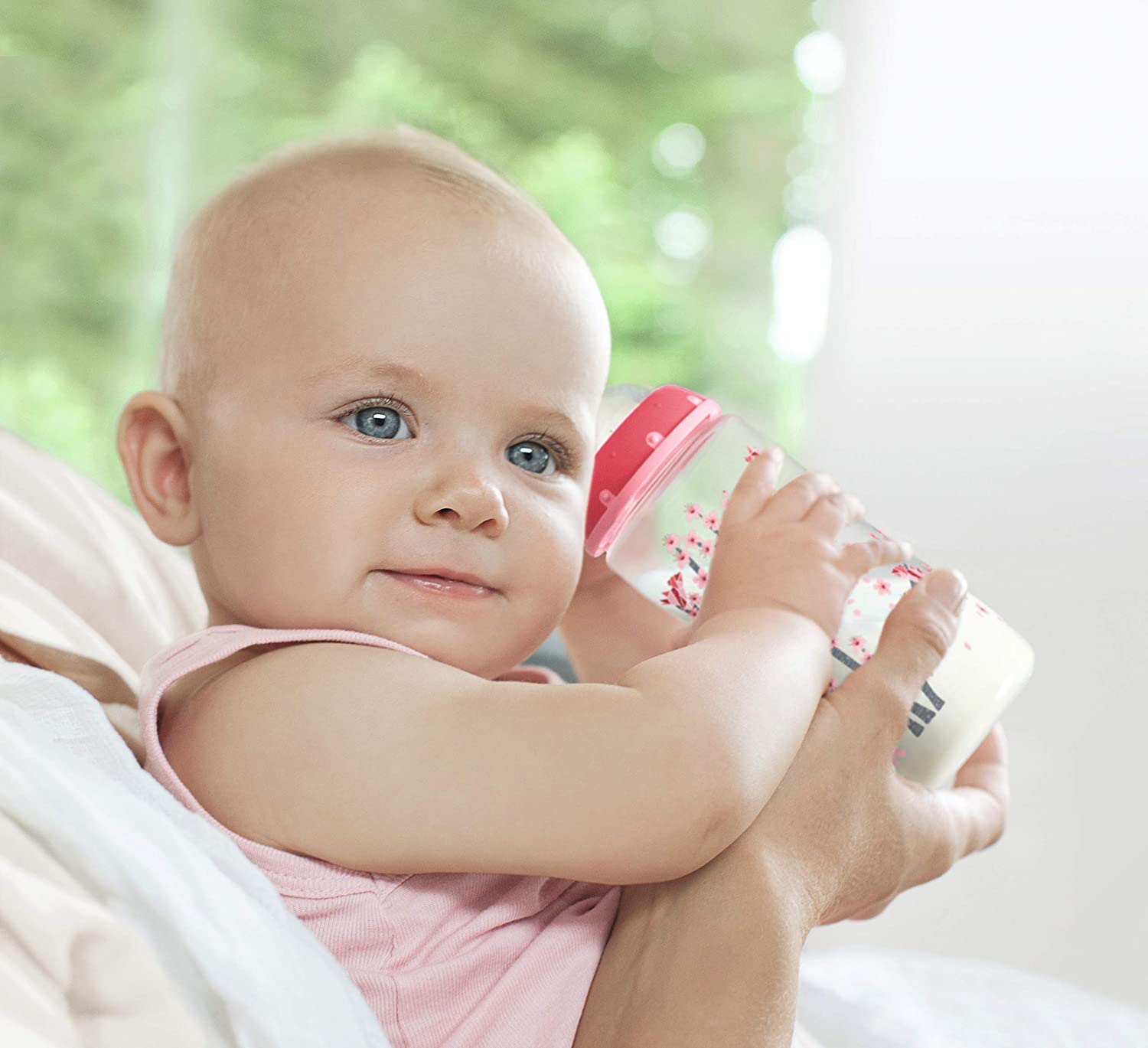

Thank you once again for bringing this to light Tamara. It’s because of what you teach that I found that the glass bottles we were using for our little one, tested positive for lead. I was using a well known Australian brand called Minbie and I had even suggested this brand to so many people asking for good glass bottles and breast like nipples on mom facebook groups (I have since deleted those suggestions). So much for trying to use something non toxic. I asked for a full refund of every nipple and bottle (after showing them the results), which they honoured. Even though we received a refund, it doesn’t come close to making you feel better that you unknowingly endangered your child, trusting that these companies would not be selling products so dangerous to someone’s life. I can’t believe this is STILL happening in 2021, and regarding products used for the most vulnerable, our babies.
Thank you again for all you do!
Have you by chance tested the parents choice glass baby bottles?
I’m over here worried sick that I’ve been poisoning my baby I’ve used them since she was born and the paint has worn completely off a few of them
Someone would have to send me one to test:
Here’s how: https://tamararubin.com/2019/08/tamara-can-i-send-you-one-of-my-dishes-to-test-for-lead/
T
Hi Tamara,
Thank you so much for this important work you do! I’ve learned so much about how to keep my family safe from reading your articles. I am extremely alarmed by your findings with the Nuk bottles. I have been using the plastic Nuk bottles with my son for a few months now and was freaking out at your findings. However, I saw in your other article that you mention in a comment that all the plastic Nuk bottles you tested were lead free. Before I go subject my son to a lead test he may not need, I want to make sure I’m understanding you accurately that you only found lead in the glass bottles and none in the plastic. If so, do you have any idea why this would be? Is there something about glass that requires a different kind of paint to stick to it something? Why would the glass be lead and plastic not? Thanks again! I plan to use different bottles from now on but I’d rather not give my son a lead test unless it seems necessary.
Hi Lindsay – yes, it is only on the glass bottles – not the plastic…. and yes – it is because it “sticks well” to glass – although there are lead free paints that also stick well to glass so there is no excuse. If you have not yet gotten a baseline lead test for your baby (regardless of concern for exposure) I always encourage that – so you have something to refer to in the future if there is an expected exposure: https://tamararubin.com/2019/02/blood-lead-testing-please-get-everyone-in-the-family-tested-since-you-have-been-living-in-a-house-with-high-lead-paint/
Tamara
I worked in a laboratory for a decade. The co i worked for often purchased electronic components from China. We would do random spit checks on these items. When I received the items from China, they always came with full laboratory reports that guaranteed California Prop 65 and Consumer Product Safety Commission compliance. Not one product, not a single one randomly tested ever passed 3rd party testing. We had reports stating zero lead, ever dang item used lead paint. China does NOT CARE! If anything is made there you can bet the farm it contains hazardous materials. Do NOT buy any items from China that would be or reasonably expected to enter your child’s mouth (so pretty much every dang toy and item for them)